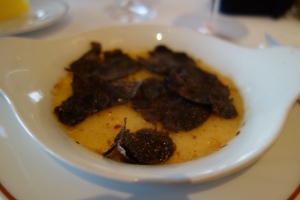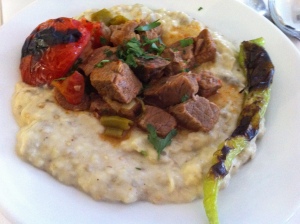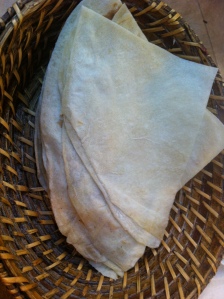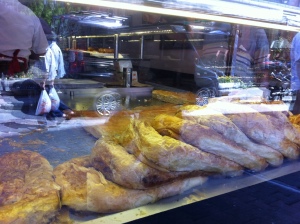*** WORLD ***
1. Vedat Milor’s Review of Apicius. All of Vedat Milor’s reviews are worth reading (I am personally running through his archives to plan a May/June Paris jaunt as we speak), but this review resonated especially, because of his mini-essay decrying Michelin’s penchant for “beautifully designed, tiny, and precious multi-courses meals, at the expense of restaurants which do true justice to ingredients.” as well as research-lab restaurants:
I do not consider the Restaurant Magazine and top 50 list a credible source to take seriously. But the “Guide Michelin” too, unfortunately, has been promoting beautifully designed, tiny, and precious multi-courses meals, at the expense of restaurants which do true justice to ingredients.
It is hard to fathom the overall influence and cultural hegemony of Japanese Kaiseki cuisine over the Guide. Japanese Palace Cuisine has great merits, but may not easily be transported elsewhere.
I would blame Michelin for caving in and promoting the superstar-chef phenomena (and for some reason women are not part of the inner circle and they remain on the fringes).
A related issue is the fact that Michelin has rewarded chefs who became entrepreneurs by giving their name to restaurants in exchange for material incentives. Dine in the two and three macaroon Robuchon Ateliers, Tables, etc. Once in a while you can eat well, but in general the food is disappointing, sometimes mediocre. In the Keller establishments, the French Laundry, Per Se, etc., the food is uninspiring, may warrant one macaroon, not three. Gagnaire can only turn out great dishes when he is in the kitchen and when one orders a la carte (try lievre a la royale). Ducasse somehow manages to satisfy in Louis XV, but even there it is nowhere near to the early ‘90s, when Louis XV was a great restaurant.
The Michelin Guide has become too politicized and too much part of big business circles, to keep its credibility. It is inconceivable that Arzak in San Sebastien keeps its three macaroons, whereas Zuberoa has been reduced to one and Elkano, arguably one of the top three fish restaurants in the world, is solely mentioned in the guide. The Michelin guide is also unreliable for Italy. Recently they have promoted Duomo in Alba and Osteria Francescana in Modena to the top three macaroon status. I had two meals in the former and one in the latter and found both of them wanting. My friend, ex-gastoville partner and now the chef of Hedone in London (you must try it if you are in London), will probably give 7/20 to both. I am more generous and rank the former 11/20 and the latter 12/20. You can have some interesting and some badly conceived dishes in these restaurants, but I guarantee that you will not eat a satisfactory meal showcasing the purity of ingredients (except the reggiano parmesan and the veal ragu pasta at Osteria Francescana). It is ludicrous to rank restaurants that high which are more like research labs and concoct half baked, experimental and too precious, teeny-tiny and odd dishes, which look like Van Gogh but taste like carbon paper. These chefs are primarily interested in creating infinitesimal variations on the “texture” of ingredients by using molecular techniques, and I wish them good luck. But it is unfortunate that a serious French guide sends the wrong signals to the young chefs by elevating these restaurants to the highest status.
In trying to please the judges, like Michelin and the jury of the “top 50”, who are the arbiters of taste, many great chefs are making unfortunate compromises.
I take my hat off to Vigato for paying no attention to such trends and expectations of the modern public which is obsessed with fat and heavy sauces.
It seems to me that Monsieur Vigato is still cooking primarily to please himself. I am sure that he is one of the very very few two to three macaroon chefs who likes to eat what comes out from his kitchen.
It is also good to see that he is financially very successful. The French love his restaurant which is always full. The beautiful “hotel particulier” where the restaurant is located used to be owned by the producer/filmmaker Luc Besson who recently sold the gorgeous property to an American closed fund.
From all I have been saying so far, it would be wrong to conclude that I am against the tiny portions in multi-course meals.
Sometimes the quality and nature of the ingredients warrant tiny portions. For instance, recently I had a memorable meal at IN DE WULF, and chef Kobe Desramault designs a menu around small portions, but they are well thought out. He also knows how to cook a lobster or a pigeon whole. Ironically the Michelin Guide rewards only one macaroon to this restaurant.
It is no secret that in a large number of Michelin restaurants, chefs buy previously sliced and vacuum packed pieces of fish and meat. Sous viding is efficient, easy, cost effective, and many customers like it because dishes cooked sous vide become soft and uniform in texture.
But, with a few exceptions, sous viding is the modern day restaurant equivalent of industrial, TV food. Making it look beautiful and painting the dish with multi-color brush strokes does not change its fundamental character. (What happened to true sauces?)
I have eaten at Apicius eight to ten times, and I can also attest to the consistency of the kitchen.
I love the fact that chef Vigato tailors the scale of his offerings to bring out the best in the material at hand.
This is why he cooks many dishes for two people.
No. He will not buy every joint of a duck precooked or presliced and vacuum packed (to be later sauced and arranged on the plate with a few sprigs of herbs) as many macaroon and top 50 chefs do.
If he serves duck, he will roast it to order and serve it for two. He will also sauce it in the tradition of the grand French cuisine.
Don’t miss his roasted wild Breton turbot on the bone for two. It is the best turbot you can have in Paris.
Try his whole lobe of sweetbread. It is among the very best in Paris. (Other great fresh sweetbreads I had were at L’Ambroisie, Ledoyen, and La Repaire de Cartouche.)
All of these dishes are excellent because they are cooked to order from high quality and fresh ingredients.
How many so called “top 50” restaurants are doing the same?
Another reason I love Vigato’s cooking is because he makes great SAUCES. The sauce was one of the hallmarks of French cuisine, and the great chef Robuchon is known to never have reheated a sauce.
Making a classic French sauce is very time and labor consuming. I doubt many apprentices and young chefs today know how to make a classical sauce, without using agar agar, xantam gum, etc. Three macaroon kitchens are now invaded by Adria products/chemicals because of obvious reasons.
All this said, don’t think that you will eat heavy food at Apicius.
2. The Rise and Fall of eGullet. A great history on the first-wave of internet gourmands, who congregated on eGullet and formed lifetime friendships. Many of them still blog today, like Docsconz, Gastromondiale, and Ulterior Epicure. But eGullet also fine-tuned the early dishes at Alinea, and inspired the Modernist Cuisine project by Nathan Myhrvold! “The site was filled with fascinating, generally friendly discussion from people in all walks of life with one major thing in common – a love and passion for food. Quite a few of the people posting on the site were culinary professionals, many of whom were already very well known like Jose Andres, Paula Wolfert, Anthony Bourdain, Michael Ruhlman and Nathan Myrhvold, who at the time was best known as the Chief Technical Officer for Microsoft, but later via the initial inspiration from eGullet went on to lead the project that became Modernist Cuisine; some of whom were becoming well known like Sean Brock, David Kinch, Alex Talbot and Aki Kamozawa amongst many others and as it turned out, there were many posting who weren’t particularly well known or even culinary professionals at the time, but subsequently became so, like Mikael Jonsson of the restaurant Hedone, Don Lee and John Deragon amongst others. There were also those, who like myself discovered a passion for culinary documentation. This would include people like Bonjwing Lee – the Ulterior Epicure, amongst others.” – Docsconz
Social media now showcases up and coming food writers but Lynes sees two key differences between eGullet and social media. The early days of eGullet were “filled with a real sense of exploration and discovery because eGullet was participant and not PR led. What’s going on now, people getting excited about ramen, burgers, pizza, doughnuts etc – I look at the early days on eGullet and it was all there, but with more depth and substance.” eGullet was famous for argument and debate about food. “There was no ‘me too’ mentality, the opinions were tested” said Lynes.
Majumdar sees a distinction in motives between the eGullet writers and the social media herd today “In 01-02 no one had any desires to launch careers from it. The notion that it was a fulltime career was a million miles from my mind. I just wanted a few people to read it [my blog].” But he is optimistic for aspiring writers, “People fascinated with anything will find an outlet to talk about it and in 01-02 there was no blog to book outlet. Now they [the writers] have outlets like social media, but they still have to be good.”
But according to this story, it all came apart when:
The camaraderie and revelry amongst the eGullet family were about to change. Lynes was given orders to ensure the board members stayed on topics, didn’t stray from talking about food and above all prevent it becoming a virtual chat room for arranging real life meetings. Lynes said that it was “an attempt to control the way people acted in real life through the boards. It really pissed people off.”
This was the beginning of eGullet’s demise. eGullet originally attracted people dissatisfied from other food sites, who didn’t want their contributions hampered by arbitrary censorship rules or membership agreements or controls. Majumdar was irritated remembering the rules “people moved to eGullet because the Chowhound rules became too prohibitive.” Majumdar conceded that growth needs a level of control but the eGullet rules and interference from the moderators was annoying.
Majumdar said that the “breaking point came when a policy about real time events was brought in an attempt to restrict people getting together in real life.” The motive behind the decision made some sense. Lynes contended that “Steve [Shaw] wantedto prevent the site creating cliques and alienating other users; it should have promoted inclusiveness.” That didn’t work out well as Lynes explained “A meet-up would have to be pre-approved by a moderator, then you could post about the event. Any report back would have to be about the food.”
*** SINGAPORE ***
3. Aun Koh of ChubbyHubby has written a manifesto on how the government should support the Singapore restaurant scene.
If we really care about food, I believe our government should establish a National Food (or Culinary) Agency, akin to the National Arts Council that can take on the duties of holistically driving our food sectors. This agency should promote our top talents locally, regionally and globally. It should open doors (internationally) for our food heroes to further build their reputations and their businesses. It should fight for our food businesses and help develop or change policies to make doing business here easier and more efficient. It should assist in spearheading new innovations that can help the sector grow. And it should assist in developing capacities and capabilities within the sector. It should educate citizens and food producers alike on diet-related health issues and promote wellness and nutrition. It should promote best practices and learning within the sector. It should work to preserve our food culture and heritage and find ways to archive, showcase and pass on knowledge. It should position Singapore as a true food capital and be able to fund programs and platforms that help ensure or cement this position.
I agree in large part with the spirit of this proposal, and hope I get the time to talk more about this of type proposal later on, when time permits. As I’ve remarked before, Singapore is a place where one eats well for $300, and reasonably well for ~$3, but the mid-range is sorely lacking, with such dire fare as like the overpriced tapas-bar Lolla, culinary-twerking 2am:dessertbar, and countless other offenders. Aun, I think, is trying to solve the problem of this mid-range chasm. As I mentioned in a comment on his post:
I think this is absolutely right. There are Singaporeans who are working at top kitchens in New York like Daniel, Momofuku Ko, who have little desire to return to Singapore because there isn’t a local culture of innovative food besides maybe 3-5 restaurants. (not talking about overpriced tapas)
On a recent trip to South America, I realised that countries like Bolivia are starting to create their own food festivals, and the Spanish-speaking restaurant world has Madrid Fusion. Latin American chefs and chefs in the Northeast US (where I currently live) constantly exchange ideas over Twitter and Instagram. This interconnectivity is why there is a creative explosion happening in the Latin world and the Northeast now.
There definitely is space for at least two things:
1. for Singapore to become a Southeast Asian mecca for fine dining
2. to export restauranteers to bring Singaporean hawker food elsewhere (like what Bourdain plans to do in NYC, and is happening in Copenhagen)
And Aun replies:
Thanks Kenneth. Agree. It is no coincidence that Jungsik, a restaurant partially underwritten by the Korean government, was able to earn 2 Michelin stars and help spread awareness of new Korean food in the USA and most importantly in the media centre of America.
If I were a government official in charge of promoting Singapore food, I’d be daunted. American food is undergoing an amazing renaissance – The Willows Inn, birch, Aska, atera, elements – are all great restaurants opened in the past few years, that’ve turned to an ingredients-first philosophy. The established giants like per se and Blue Hill are doing that too. However I think it is due to the increasingly good quality of produce available throughout American farms. I think that Singapore can become a Southeast Asian mecca for fine dining if we get the right logistics to ship ingredients from Borneo/Sumatra/Java and farms in the peninsula that focus on premium produce – but I don’t think Southeast Asian agriculture has this mindset just yet. To illustrate, Chef Andre Chiang, when I dined at his restaurant last summer, said he had faced difficulties communicating to local farmers his preferred methods of raising good agriculture. Therefore the immediate challenges in the fine dining space would be three-fold:
- (Ingredients) Build up a network of farms in the Malayan peninsula that sets aside a percentage of their output for premium ingredients.
- (People) Start enticing recent graduates of premier cooking schools in the world like the Culinary Institute of America to come back to Singapore. This can be done by subsidising restaurant spaces, grants etc. But ultimately great cooks want to cook for an appreciative audience. The government should work on the assumption that this appreciative audience can be brought into being within 5 years.
- (Foreign Promotion) I think the prospect of grants to set up restaurants in foreign countries, contingent on success within a 5 year trial period, will be a huge incentive to potential talent.
Since the problem of fine-dining restaurants in Singapore is complex and inter-related, only a concerted big push will solve the problem.
For hawker food, I’ll have more to say in separate post. But it’s a complex problem too, and we are in danger of losing our hawker food culture. The last link lists some reasons why:
4. Making no bones about that young bak kut teh hawker’s business.
The Kitchen At The Centre Of It All.
Interestingly, Jun Yuan also mentioned that at some point, for his business to truly work, they would need to expand to four to five outlets, and with a central kitchen supplying them. He said this when he posted his stall’s impending closure:
“You may or may not know that our model has always been premised on having more outlets.”
What’s more interesting than what he said, was what he didn’t say. Consider this – Jun Yuan is a first-class honours graduate in Management from the University of Manchester. One can safely assume that he has some idea of how to put together a business plan, forecast for various case scenarios and run some numbers to arrive at the conclusion that for a food business in Singapore to succeed and thrive, one needs scale. A scale that requires at least four to five different branches – a number of profit centres that help support one cost centre (the central kitchen) – in order to generate a healthy cash flow.
This is, if one reads between the lines, quite revealing. It shows two things:
1. Most food businesses in Singapore, in order to survive and thrive, require sufficient capital to provide the runway so that they can build the kind of scale required, and that’s likely to be to the tune of millions; and
2. That commercial rentals have skyrocketed beyond a tipping point such that most food businesses, even those that run hawker stalls, require the facilities of a central kitchen somewhere else – usually located in industrial estates with far cheaper rents – in order to manage costs.
Central kitchens are fantastic facilities in that they can generate a large quantity of food in very short amount of time at possibly lower prices due to economies of scale, streamlining of duplicated functions and higher automation. But many food businesses – aside from catering services or large-scale food service businesses such as hotels – previously never needed to use central kitchens because it has always been that what was produced onsite is sufficient to cater for the required number of customers to help keep the business afloat. The fact that central kitchens are now a key factor in determining whether a food business can take off only means that existing kitchen facilities within each establishment may be insufficient to produce enough food quickly to supply the larger number of customers needed to sustain the business. This is worrying.
Make no bones about it – this means that there’s even less breathing room for small, independent food businesses in Singapore, moving forward. And that their chances of success have just shrunk to an even more diminutive number.
































































